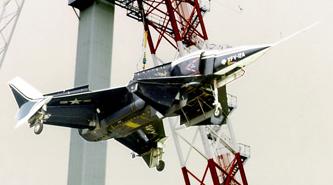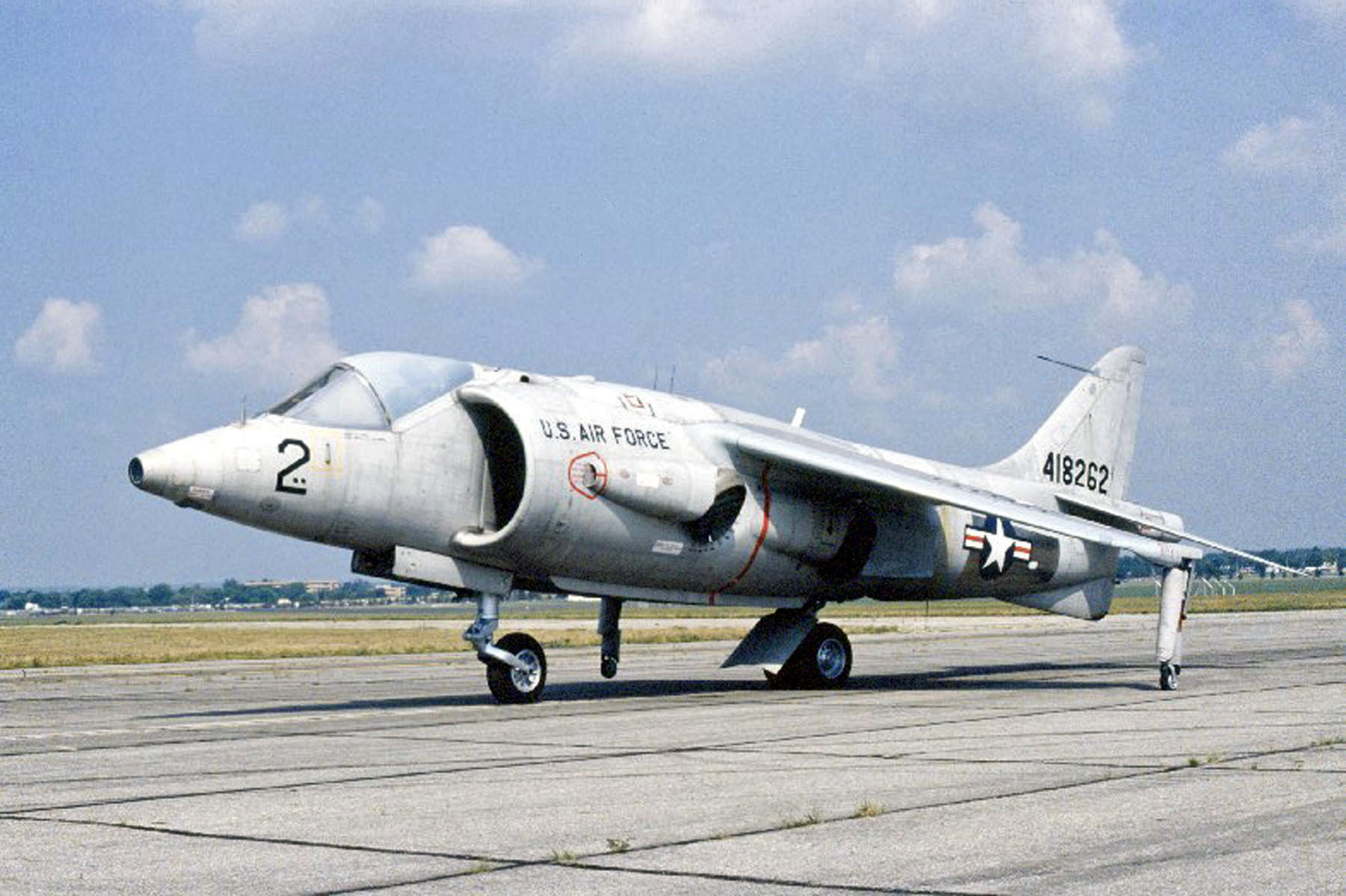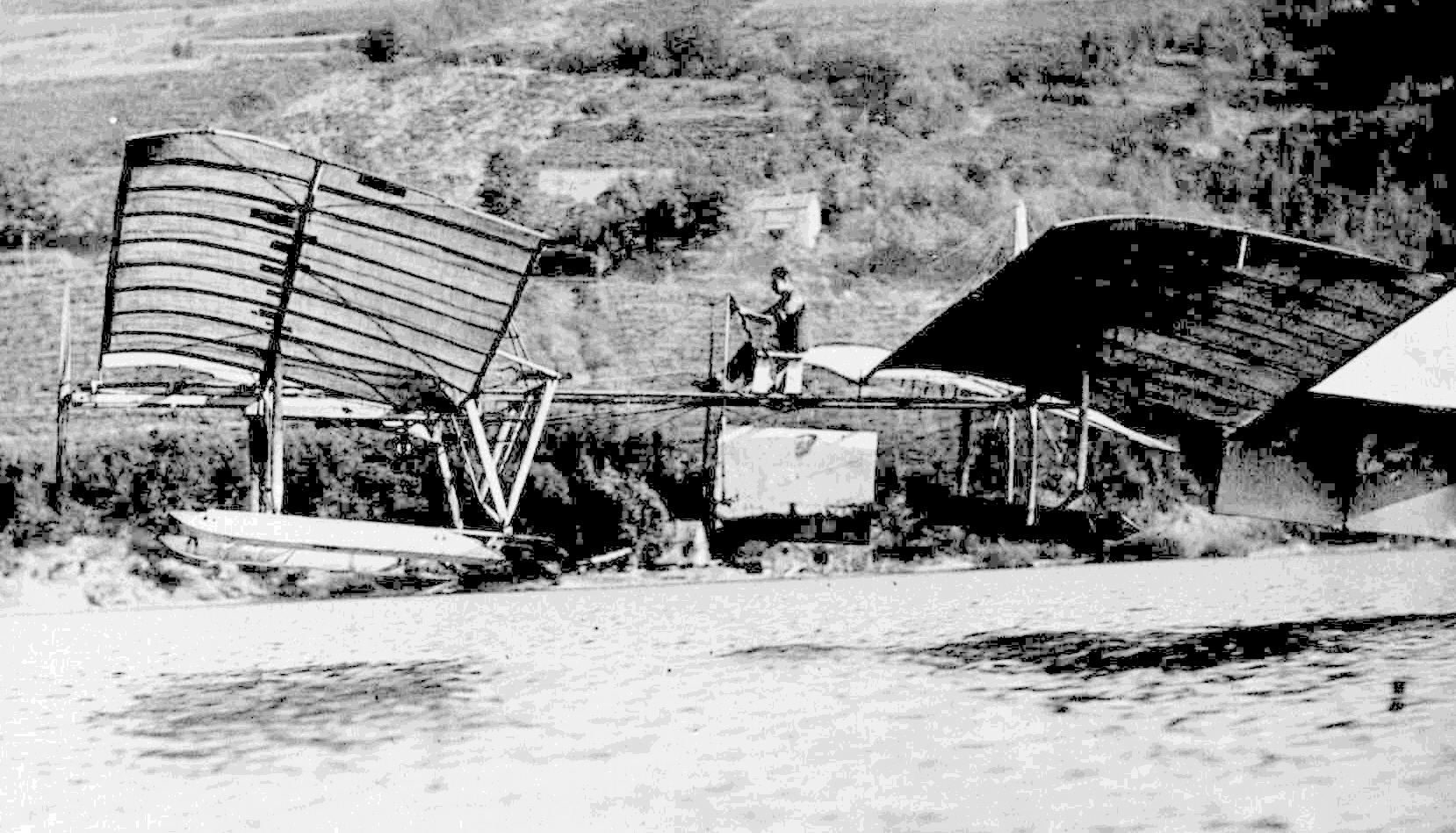|
XFV-12
The Rockwell XFV-12 was a prototype supersonic United States Navy fighter which was built in 1977. The XFV-12 design attempted to combine the Mach 2 speed and AIM-7 Sparrow armament of the McDonnell Douglas F-4 Phantom II in a VTOL (vertical takeoff and landing) fighter for the small Sea Control Ship which was under study at the time. On paper, it looked superior to the subsonic Hawker Siddeley Harrier attack fighter. However it was unable to demonstrate an untethered vertical takeoff and its inability to meet performance requirements terminated the program. Design and development In 1972, the Navy issued a request for proposals for a next generation supersonic V/STOL fighter/attack aircraft. Rockwell's design with the XFV-12 won against Convair's proposal with the Convair Model 200. The XFV-12A, despite its concept being considered risky compared to that of the Harrier, was selected for development. To reduce costs, the nose from a Douglas A-4 Skyhawk and intakes fro ... [...More Info...] [...Related Items...] OR: [Wikipedia] [Google] [Baidu] |
Convair Model 200
The Convair Model 200 was a design for a supersonic vertical takeoff and landing (VTOL) fighter requirement for the United States Navy Sea Control Ship. Further versions were planned for conventional catapult launches and landing using the arresting gear. Design and development The Convair Model 200 was designed in 1973 as a single-jet fighter, that could be built in both vertical takeoff and landing (VTOL) (model 200A) and conventional takeoff and landing (CTOL) configurations (Model 201A). For the CTOL, the single Pratt & Whitney JTF22A-26A with tail hook, canard with flap, and CTOL tail cone. For the VTOL operations, the single Pratt & Whitney JTF22A-30A with a jet exhaust pipe tiltable by 90 degrees using a three-bearing swivel nozzle, and two additional lifting engines with 46.7 kN thrust each were provided behind the cockpit. The lifting engines and the swiveling nozzles were eliminated in the CTOL versions. The top speed was Mach 2. The wingspan was 27 feet 10.5 inches; ... [...More Info...] [...Related Items...] OR: [Wikipedia] [Google] [Baidu] |
XV-4 Hummingbird
The Lockheed XV-4 Hummingbird (originally designated VZ-10) was a U.S. Army project to demonstrate the feasibility of using VTOL for a surveillance aircraft carrying target-acquisition and sensory equipment.Hummingbird A Promising Augmented-Jet VTOL Aircraft '''', 3 April 1962 It was designed and built by the in the 1960s, one of many attempts to produce a |
Sea Control Ship
The Sea Control Ship (SCS) was a small aircraft carrier developed and conceptualized by the United States Navy under Chief of Naval Operations Elmo Zumwalt during the 1970s. Currently the term refers to naval vessels that can perform similar duties.Sea Control Ship – GlobalSecurity.org The SCS was intended as an escort vessel, providing air support for convoys. It was canceled after budgetary cuts to the US Navy. The SCS was to be equipped with a mix of and |
Hawker Siddeley Harrier
The Hawker Siddeley Harrier is a British military aircraft. It was the first of the Harrier series of aircraft and was developed in the 1960s as the first operational ground attack and reconnaissance aircraft with vertical/short takeoff and landing (V/STOL) capabilities and the only truly successful V/STOL design of that era. The Harrier was developed directly from the Hawker Siddeley Kestrel prototype aircraft, following the cancellation of a more advanced supersonic aircraft, the Hawker Siddeley P.1154. In the late 1960s, the Harrier GR.1 and GR.3 variants were ordered by the British government for the Royal Air Force (RAF). It was exported to the United States as the AV-8A, for use by the US Marine Corps (USMC), in the 1970s. During the Harrier's service the RAF positioned the bulk of the aircraft in West Germany to defend against a potential invasion of Western Europe by the Warsaw Pact forces; the unique abilities of the Harrier allowed the RAF to disperse their forces a ... [...More Info...] [...Related Items...] OR: [Wikipedia] [Google] [Baidu] |
Lockheed Martin F-35 Lightning II
The Lockheed Martin F-35 Lightning II is an American family of single-seat, single-engine, all-weather stealth multirole combat aircraft that is intended to perform both air superiority and strike missions. It is also able to provide electronic warfare and intelligence, surveillance, and reconnaissance capabilities. Lockheed Martin is the prime F-35 contractor, with principal partners Northrop Grumman and BAE Systems. The aircraft has three main variants: the conventional takeoff and landing (CTOL) F-35A, the short take-off and vertical-landing (STOVL) F-35B, and the carrier-based (CV/ CATOBAR) F-35C. The aircraft descends from the Lockheed Martin X-35, which in 2001 beat the Boeing X-32 to win the Joint Strike Fighter (JSF) program. Its development is principally funded by the United States, with additional funding from program partner countries from NATO and close U.S. allies, including the United Kingdom, Australia, Canada, Italy, Norway, Denmark, the Netherland ... [...More Info...] [...Related Items...] OR: [Wikipedia] [Google] [Baidu] |
V/STOL
A vertical and/or short take-off and landing (V/STOL) aircraft is an airplane able to take-off or land vertically or on short runways. Vertical takeoff and landing (VTOL) aircraft are a subset of V/STOL craft that do not require runways at all. Generally, a V/STOL aircraft needs to be able to hover. Helicopters are not considered under the V/STOL classification as the classification is only used for aeroplanes, aircraft that achieve lift (force) in forward flight by planing the air, thereby achieving speed and fuel efficiency that is typically greater than the capability of helicopters. Most V/STOL aircraft types were experiments or outright failures from the 1950s to 1970s. V/STOL aircraft types that have been produced in large numbers include the F-35B Lightning II, Harrier, Yak-38 Forger and V-22 Osprey. A rolling takeoff, sometimes with a ramp ( ski-jump), reduces the amount of thrust required to lift an aircraft from the ground (compared with vertical takeoff), and h ... [...More Info...] [...Related Items...] OR: [Wikipedia] [Google] [Baidu] |
Rockwell International
Rockwell International was a major American manufacturing conglomerate involved in aircraft, the space industry, defense and commercial electronics, components in the automotive industry, printing presses, avionics and industrial products. Rockwell International's predecessor was Rockwell Manufacturing Company, founded in 1919 by Willard Rockwell. In 1968, Rockwell Manufacturing Company included 7 operating divisions manufacturing industrial valves, German 2-cycle motors, power tools, gas and water meters. In 1973, it was combined with the aerospace products and renamed Rockwell International. At its peak, Rockwell International was No. 27 on the Fortune 500 list, with assets of over $8 billion, sales of $27 billion and 115,000 employees. History Rockwell Manufacturing Company Boston-born Willard Rockwell (1888–1978) made his fortune with the invention and successful launch of a new bearing system for truck axles in 1919. He merged his Oshkosh, Wisconsin-base ... [...More Info...] [...Related Items...] OR: [Wikipedia] [Google] [Baidu] |
Canard (aeronautics)
In aeronautics, a canard is a wing configuration in which a small forewing or foreplane is placed forward of the main wing of a fixed-wing aircraft or a weapon. The term "canard" may be used to describe the aircraft itself, the wing configuration, or the foreplane.. Canard wings are also extensively used in guided missiles and smart bombs. The term "canard" arose from the appearance of the Santos-Dumont 14-bis of 1906, which was said to be reminiscent of a duck (''canard'' in French) with its neck stretched out in flight. Despite the use of a canard surface on the first powered aeroplane, the Wright Flyer of 1903, canard designs were not built in quantity until the appearance of the Saab Viggen jet fighter in 1967. The aerodynamics of the canard configuration are complex and require careful analysis. Rather than use the conventional tailplane configuration found on most aircraft, an aircraft designer may adopt the canard configuration to reduce the main wing loading, to better ... [...More Info...] [...Related Items...] OR: [Wikipedia] [Google] [Baidu] |
Tandem Wing
QAC Quickie Q2 A tandem wing is a wing configuration in which a flying craft or animal has two or more sets of wings set one behind another. All the wings contribute to lift. The tandem wing is distinct from the biplane in which the wings are stacked one above another, or from the canard or "tail-first" configuration where the forward surface is much smaller and does not contribute significantly to the overall lift. In aviation, tandem wings have long been experimented with, but few designs have ever been put into production. Tandem wings in nature occur only in insects and flying fish, although in the past there have been tandem-wing flying dinosaurs. Design principles A tandem wing configuration has two main wing planes, with one located forward and the other to the rear. The difference is greater than the wing chord, so there is a clear gap between them and the aircraft centre of gravity (CG) lies between the wings.Bottomley (1977) Compared to the conventional layout, wher ... [...More Info...] [...Related Items...] OR: [Wikipedia] [Google] [Baidu] |
Turbofan
The turbofan or fanjet is a type of airbreathing jet engine that is widely used in aircraft engine, aircraft propulsion. The word "turbofan" is a portmanteau of "turbine" and "fan": the ''turbo'' portion refers to a gas turbine engine which achieves mechanical energy from combustion, and the ''fan'', a ducted fan that uses the mechanical energy from the gas turbine to force air rearwards. Thus, whereas all the air taken in by a turbojet passes through the combustion chamber and turbines, in a turbofan some of that air bypasses these components. A turbofan thus can be thought of as a turbojet being used to drive a ducted fan, with both of these contributing to the thrust. The ratio of the mass-flow of air bypassing the engine core to the mass-flow of air passing through the core is referred to as the bypass ratio. The engine produces thrust through a combination of these two portions working together; engines that use more Propelling nozzle, jet thrust relative to fan thrust are ... [...More Info...] [...Related Items...] OR: [Wikipedia] [Google] [Baidu] |
WikiProject Aircraft
A WikiProject, or Wikiproject, is a Wikimedia movement affinity group for contributors with shared goals. WikiProjects are prevalent within the largest wiki, Wikipedia, and exist to varying degrees within sister projects such as Wiktionary, Wikiquote, Wikidata, and Wikisource. They also exist in different languages, and translation of articles is a form of their collaboration. During the COVID-19 pandemic, CBS News noted the role of Wikipedia's WikiProject Medicine in maintaining the accuracy of articles related to the disease. Another WikiProject that has drawn attention is WikiProject Women Scientists, which was profiled by '' Smithsonian'' for its efforts to improve coverage of women scientists which the profile noted had "helped increase the number of female scientists on Wikipedia from around 1,600 to over 5,000". On Wikipedia Some Wikipedia WikiProjects are substantial enough to engage in cooperative activities with outside organizations relevant to the field at issue. For e ... [...More Info...] [...Related Items...] OR: [Wikipedia] [Google] [Baidu] |
Columbus, Ohio
Columbus () is the state capital and the most populous city in the U.S. state of Ohio. With a 2020 census population of 905,748, it is the 14th-most populous city in the U.S., the second-most populous city in the Midwest, after Chicago, and the third-most populous state capital. Columbus is the county seat of Franklin County; it also extends into Delaware and Fairfield counties. It is the core city of the Columbus metropolitan area, which encompasses 10 counties in central Ohio. The metropolitan area had a population of 2,138,926 in 2020, making it the largest entirely in Ohio and 32nd-largest in the U.S. Columbus originated as numerous Native American settlements on the banks of the Scioto River. Franklinton, now a city neighborhood, was the first European settlement, laid out in 1797. The city was founded in 1812 at the confluence of the Scioto and Olentangy rivers, and laid out to become the state capital. The city was named for Italian explorer Christopher Columbus. ... [...More Info...] [...Related Items...] OR: [Wikipedia] [Google] [Baidu] |

_during_Dragon_Hammer_92.jpg)




_(9256079273).jpg)

